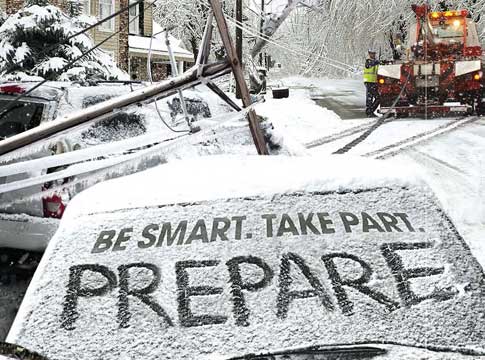Related News
Related News
-
Let's Talk Turkey. Is your family ready for winter?
We're heading into the holidays, but that also means snow, ice, and not-so-nice weather might be in the forecast. Here are some tips to prepare in advance.
Find Out More -
EWEB Partners with Eugene School District 4J to Celebrate New Kennedy Middle School Emergency Water Station Site
Hundreds of attendees practiced filling up water containers at Saturday's demonstration event.
Find Out More -
Electric Projects underway in North & South Eugene
Underground lines and disaster-resilient power poles are part of EWEB’s infrastructure upgrade near Eugene’s largest natural resource area.
Find Out More -
Join the Pledge to Prepare
When you think about getting ready for an emergency, you probably have questions. You aren't alone. Preparing for emergencies can be overwhelming, which is why EWEB has put together a 12-month program to help you and your family get two weeks ready.
Find Out More -
You can’t predict the next disaster, but you can prepare
The earthquake lasted less than a minute. But now the power’s out. The tap runs dry. Cell service is spotty. Would you be ready?
Find Out More -
EWEB prepares for wildfire season with risk mitigation measures
EWEB is building a more resilient electric system to weather various types of disasters, from wildfire to winter storms.
Find Out More -
EWEB Pilots New Line Safety Program for 4th graders.
This year, EWEB is ramping up power line safety for children, specifically 4th graders.
Find Out More -
Hayden Bridge celebrates 75 years of service as EWEB looks forward to a new era of water resiliency
EWEB Water Treatment Supervisor, Toby Dixon, looks back at how the Hayden Bridge Water Filtration Plant has changed over the years and explains what EWEB is doing to secure a more resilient water future.
Find Out More -
Watch the Recording: Financial Preparedness for Disasters
How will you financially recover after a disaster? This seminar gives key insights into preparing your finances ahead of time.
Find Out More -
EWEB reaffirms commitment to resilience with Wildfire Mitigation Plan approval
The utility is testing new equipment, leveraging technology, and incorporating third-party expertise to bolster electric system resiliency to a range of threats, including wildfire.
Find Out More -
Energy demand reaches highest level in nearly a decade as utility prepares for ice
Frigid temperatures in the low 20s caused surging electricity demand in early February.
Find Out More -
Recovery still ongoing on the anniversary of the 2024 Ice Storm
Cost of rebuilding EWEB's electrical system will surpass $11 million
Find Out More -
EWEB awarded $1 million for wildfire resiliency projects from Federal funding package
Funds will be used to support fuels reduction work on a landscape scale in high-risk areas in the McKenzie River Valley and Eugene South Hills.
Find Out More -
Giving the gift of preparedness
The holiday season is the perfect opportunity to help your friends and family prepare for an emergency or disaster.
Find Out More -
EWEB Communications Win National Recognition for Public Power Excellence
We’re excited to share that EWEB has again been honored with two Excellence in Public Power Communications Awards from the American Public Power Association (APPA), earning top honors in both the Web/Social Media and Video categories.
Find Out More - Show More
Resolve to be Ready in 2018
January 02, 2018

If you have a 72-hour emergency kit and a disaster plan for your family, then you have a great start on emergency preparedness. Here are some New Year's tips to help you take the next steps to be ready for whatever 2018 may bring.
Store more food and water
Your 72-hour kit is a great start and will be very helpful in a "typical" storm or power outage. But a major disaster such as a Cascadia Subduction Zone Earthquake could knock out power and water services for weeks or longer. Experts now recommend that you store 14 gallons of water per person and pets—enough for two weeks.
Get to know your neighbors
In a major disaster, professional emergency response may be delayed for hours, even days. Neighborhood connections will be especially important. Check out the Map Your Neighborhood program for a simple, step-by-step guide to help you and your neighbors prepare for an emergency.
Protect your financial well-being
Do you have copies of critical documents in a safe place that is protected from both fire and water? Are your documents available to "grab and go" in case of evacuation? Do you have emergency cash on hand? FEMA's Citizen Core and Operation Hope have developed The Emergency Financial First Aid Kit to help you prepare financially and reduce the financial impacts of disasters.
Sign up for a class
Learn skills you need to help yourself and others until help can arrive. The Eugene-Springfield CERT (Community Emergency Response Team) holds regular trainings on a variety of emergency topics, as does the local chapter of American Red Cross.
Keeping New Year's resolutions can be hard, but emergency preparedness doesn't have to be. Check out our website for handy checklists and resources, as well as tips for storing and treating water, using back-up power sources, turning off utilities in an emergency, and more.

